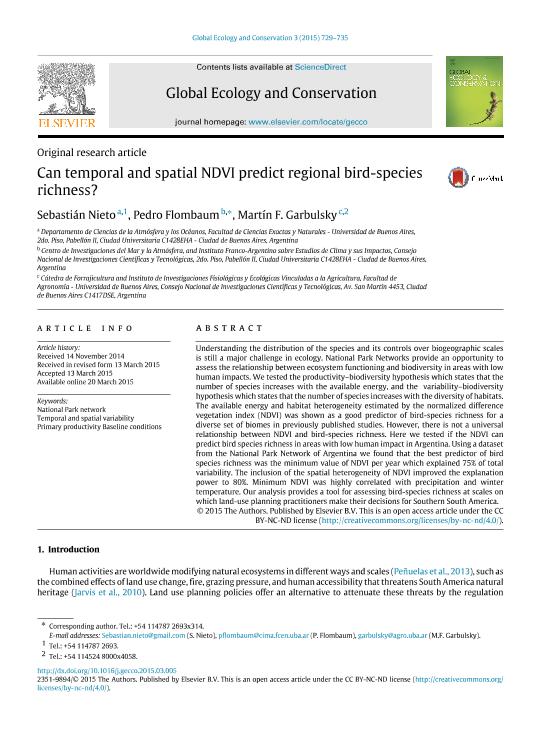Mostrar el registro sencillo del ítem
dc.contributor.author
Nieto, Sebastián
dc.contributor.author
Flombaum, Pedro

dc.contributor.author
Flombaum, Pedro

dc.date.available
2016-02-25T19:29:48Z
dc.date.issued
2015-03
dc.identifier.citation
Nieto, Sebastián; Flombaum, Pedro; Flombaum, Pedro; Can temporal and spatial NDVI predict regional bird-species richness?; Elsevier; Global Ecology and Conservation; 3; 3-2015; 729-735
dc.identifier.issn
2351-9894
dc.identifier.uri
http://hdl.handle.net/11336/4440
dc.description.abstract
Understanding the distribution of the species and its controls over biogeographic scales is still a major challenge in ecology. National Park Networks provide an opportunity to assess the relationship between ecosystem functioning and biodiversity in areas with low human impacts. We tested the productivity–biodiversity hypothesis which states that the number of species increases with the available energy, and the variability–biodiversity hypothesis which states that the number of species increases with the diversity of habitats. The available energy and habitat heterogeneity estimated by the normalized difference vegetation index (NDVI) was shown as a good predictor of bird-species richness for a diverse set of biomes in previously published studies. However, there is not a universal relationship between NDVI and bird-species richness. Here we tested if the NDVI can predict bird species richness in areas with low human impact in Argentina. Using a dataset from the National Park Network of Argentina we found that the best predictor of bird species richness was the minimum value of NDVI per year which explained 75% of total variability. The inclusion of the spatial heterogeneity of NDVI improved the explanation power to 80%. Minimum NDVI was highly correlated with precipitation and winter temperature. Our analysis provides a tool for assessing bird-species richness at scales on which land-use planning practitioners make their decisions for Southern South America.
dc.format
application/pdf
dc.language.iso
eng
dc.publisher
Elsevier

dc.rights
info:eu-repo/semantics/openAccess
dc.rights.uri
https://creativecommons.org/licenses/by-nc-nd/2.5/ar/
dc.subject
Parques Nacionales
dc.subject
Variabilidad Espacial y Temporal
dc.subject
Productividad Primaria
dc.subject.classification
Ecología

dc.subject.classification
Ciencias Biológicas

dc.subject.classification
CIENCIAS NATURALES Y EXACTAS

dc.title
Can temporal and spatial NDVI predict regional bird-species richness?
dc.type
info:eu-repo/semantics/article
dc.type
info:ar-repo/semantics/artículo
dc.type
info:eu-repo/semantics/publishedVersion
dc.date.updated
2016-03-30 10:35:44.97925-03
dc.journal.volume
3
dc.journal.pagination
729-735
dc.journal.pais
Países Bajos

dc.journal.ciudad
Amsterdam
dc.description.fil
Fil: Nieto, Sebastián. Universidad de Buenos Aires. Facultad de Ciencias Exactas y Naturales. Departamento de Ciencias de la Atmósfera y Los Océanos; Argentina
dc.description.fil
Fil: Flombaum, Pedro. Consejo Nacional de Investigaciones Científicas y Técnicas. Oficina de Coordinacion Administrativa Ciudad Universitaria. Centro de Investigaciones del Mar y la Atmósfera; Argentina
dc.description.fil
Fil: Flombaum, Pedro. Universidad de Buenos Aires. Facultad de Agronomía. Departamento de Produccion Animal. Cátedra de Forrajicultura; Argentina. Consejo Nacional de Investigaciones Científicas y Técnicas. Oficina de Coordinación Administrativa Parque Centenario. Instituto de Investigaciones Fisiológicas y Ecológicas Vinculadas a la Agricultura; Argentina
dc.journal.title
Global Ecology and Conservation
dc.relation.alternativeid
info:eu-repo/semantics/altIdentifier/url/http://www.sciencedirect.com/science/article/pii/S2351989415000311
dc.relation.alternativeid
info:eu-repo/semantics/altIdentifier/doi/http://dx.doi.org/10.1016/j.gecco.2015.03.005
dc.relation.alternativeid
info:eu-repo/semantics/altIdentifier/issn/2351-9894
Archivos asociados
